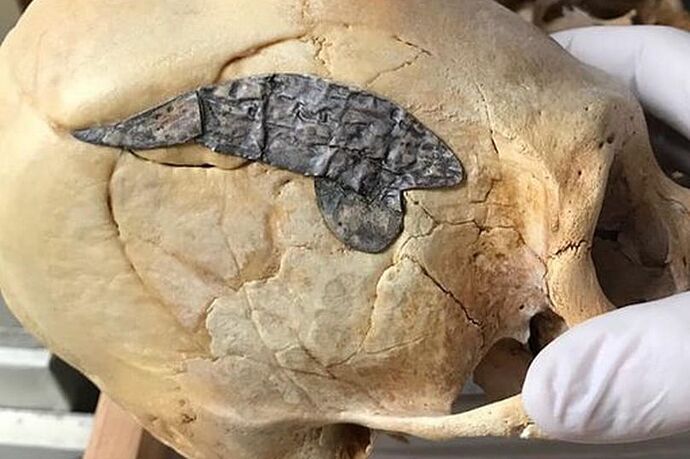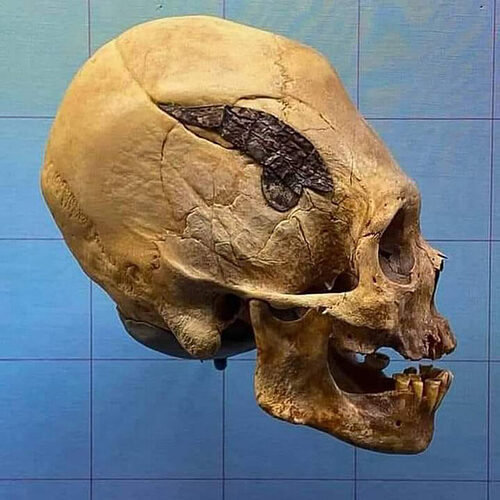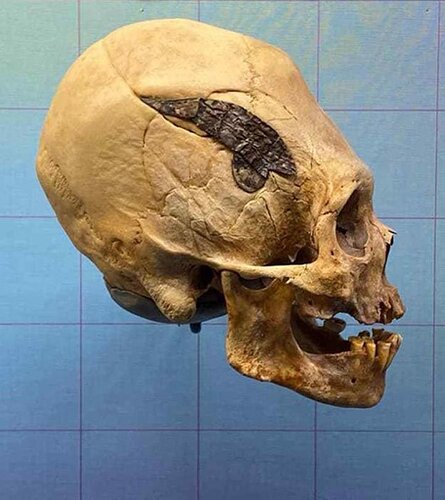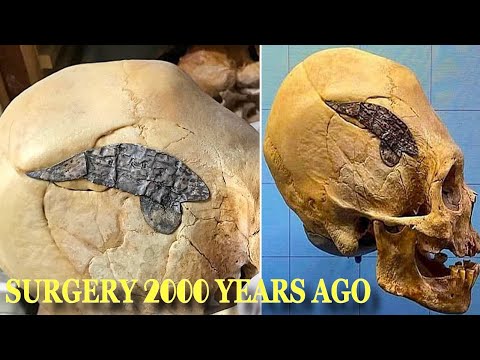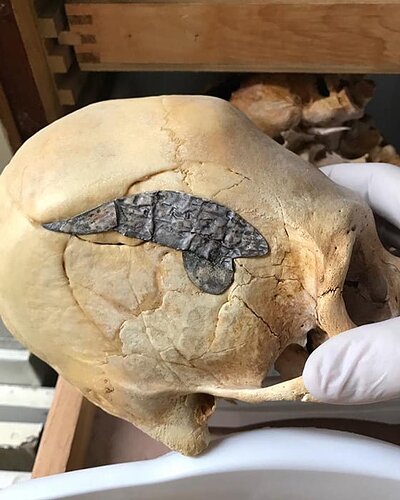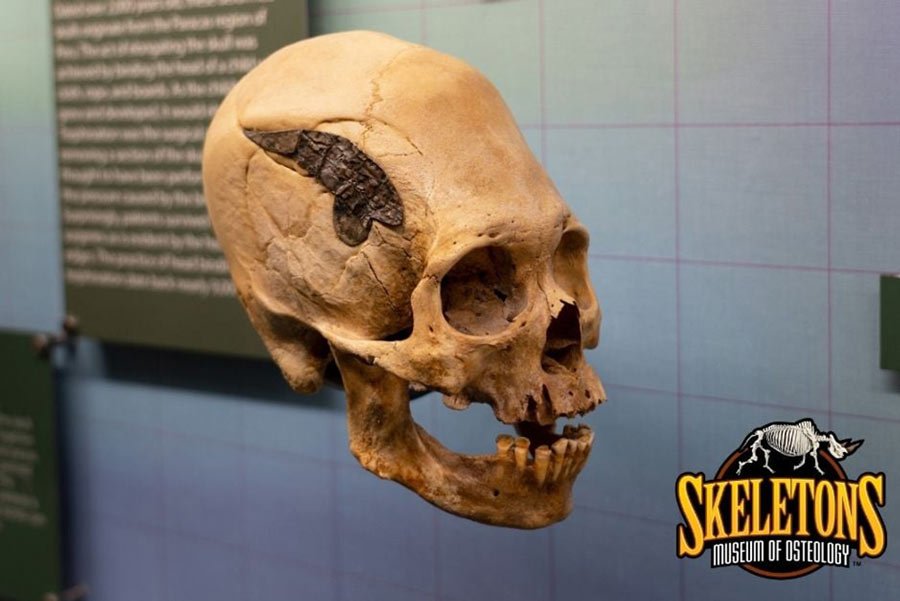
UPDATED 18 JANUARY, 2022 - 22:00 CECILIA BOGAARD
2,000-Year-Old Peruvian Skull Underwent Successful Skull Surgery
[PRINT](javascript:
A skull housed at the Museum of Osteology in Oklahoma is causing quite a stir. The ancient elongated skull, dating back 2,000 years, once belonged to a Peruvian warrior. After being injured during battle and suffering some injury to the head, skull surgery was performed - using metal - making it a stunning example of early advanced surgery.
Impressive Tomb of Royal Scribe Unveiled at Saqqara Necropolis
Understanding the History of Elongated Skulls in Peru
“We don’t have a ton of background on this piece,” stressed the Museum of Osteology . Nevertheless, this particular skull opens up a whole can of worms. First up is attempting to understand why the skull was elongated. “Elongation was achieved through head binding beginning at a very young age,” explained the Museum of Osteology when they announced that the skull was now on public display due to popular demand. “It was typically practiced to convey social status by various cultures,” they continued.
“Throughout history, many cultures have artificially deformed the skulls of babies in order to achieve a flattened or elongated shape which was often associated with the ruling, or elite classes,” explained Karen Mutton in an Ancient Origins article . Evidence of this kind of artificial cranial deformation has been discovered within the Americas, Australia, the Middle East and Russia, amongst others.
When it comes to the so-called ‘ Coneheads’ of Paracas, Peru, although some insist that they are evidence of aliens, their skulls were most likely deformed by a process of head binding which researchers believe was performed in infancy on high-ranking members of the population. “Deliberate head shaping is a form of cultural modification of the body that marks different things, like one’s identity, a rite of passage, (or) an occupation,” explained Melissa Murphy, an anthropology professor at the University of Wyoming in USA TODAY .
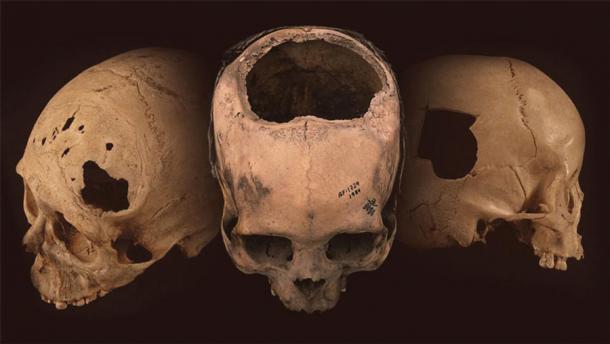
Ancient skulls bearing evidence of trepanation, a kind of skull surgery in which a telltale hole was surgically cut into the cranium, evidence for which can be found in Peru. ( University of Miami )
One of the Oldest Surgery Procedures in the World - Skull Trepanation
According to the Daily Star , the ancient skull on display at the Museum of Osteology in Oklahoma is proof that ancient Peruvians were performing advanced surgery as far back as 2,000 years ago. While this might be true, in fact, trepanation (known also as trepanning, trephining, or making a burr hole), is a surgical procedure involving the drilling of a hole in the skull of a living person, which actually goes back much further.
Considered to be one of the oldest surgical procedures in the world, evidence for trepanation is found as early as the Neolithic period. Examples of this are found at sites throughout the world, from Europe, ancient Greece, Mesopotamia, China, Russia and throughout the Inca Empire. In point of fact, National Geographic explained that “the procedure reached its apex in Peru between the 14th and 16th centuries AD.”
The objectives of trepanation throughout history have been diverse. From allowing blood to drain from the skull after injury, as described by the ancient Greek physician Hippocrates, to its use in Europe as a treatment for epilepsy and mental illness. Some have even suggested that trepanation skull surgery was performed for ritual purposes.
The Oklahoma-based museum has an early Peruvian elongated skull, which underwent skull surgery, as part of its collection. ( Museum of Osteology )
Early Skull Surgery was Common in Peru
This example seems to be different though, as a metal has been used to seal the hole in the head.
“Fractured skulls were reportedly common injuries in battle due to weapons being primarily sling stones and bashing clubs,” highlighted the Daily Star . According to anthropologist John Verano, author of Holes in the Head: The Art and Archaeology of Trepanation in Ancient Peru , who was interviewed for the article, this is why “Peruvian surgeons became experts in treating them.”
The area of the former Inca Empire has become a primary site of interest for historians of trepanation due to the profusion of trepanned skulls discovered there, many of which show signs of healed bones which lead experts to conclude that there was a high survival rate. “[Peru] has more skulls with trepanations than everywhere else in the world combined,” explained Verano in an interview with [National Geographic ]
(Amazing Things We’ve Learned From 800 Ancient Skull Surgeries).
When it comes to the 2,000-year-old Peruvian warrior skull in question, “the individual survived the procedure, known as trepanation, based on evidence of bone remodeling,” stressed the Museum of Osteology . What makes this even more surprising is that this early skull surgery would have taken place without any anesthesia or other modern medical techniques!
While it does provide evidence of early skull surgery, the Museum of Osteology skull is not, as the Daily Mail claimed, “the world’s first skull surgery.” There is evidence of skull surgery from throughout history. Ancient Origins reported on one example of skull surgery from as far back as 7,000 years ago in Sudan, making the Peruvian warrior skull pretty recent by comparison.
Peruvian elongated skull which underwent skull surgery and had metal surgically implanted to bind the bones after being wounded in battle about 2,000 years ago. ( Museum of Osteology )
The Museum of Osteology Skull Was Repaired Using Metal
The Peruvian elongated skull is one of the “more interesting and oldest pieces in the collection” housed at the Museum of Osteology in Oklahoma, stated the museum in a Facebook post. One aspect which makes it stand out from the plethora of skulls on display is that the ancient Peruvian surgeons implanted metal to help bind the broken bones, as can be seen by the dark heart/pepper-shaped form on the side of the skull.
The Oklahoma-based museum believes that the elongated skull belonged to a Peruvian warrior, wounded in battle. Based on analysis of the bones, they concluded that the warrior survived the operation. “Based on the broken bone surrounding the repair and you can see that it’s tightly fused together. It was a successful surgery,” announced the Museum of Osteology . The warrior had undergone skull elongation at a young age, which would mean that he was from the upper echelons of his society.
Questions have been asked related to the kind of metal used for this operation, but the Museum has as yet not conducted any analysis to determine its actual composition. They claim that “traditionally, silver and gold was used for this type of procedure.”
Top image: The elongated skull of a Peruvian warrior who underwent skull surgery 2,000 years ago. Source: Museum of Osteology
By Cecilia Bogaard

